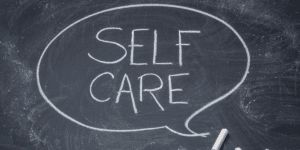If it takes a National Self-Care Awareness month to put self-care on your radar, odds are that relaxation isn’t already a big part of your daily routine.
And honestly, a couple of words on your September calendar may not be enough to jump-start healthy wellness habits, either.
But you know what can work? Some simple, actionable tips and techniques that you can master in minutes. That’s precisely what we’re here to provide.
So, let’s dig into the importance of self-care and wellness, and how something you may not be familiar with — vagus nerve stimulation — may be key to managing your stress and mood. And we’ll cap it off with a couple of quick exercises focusing on self-care and holistic wellness. That way, you can come out of National Self-Care Awareness Month feeling like your best self — recharged and ready to take on the world.
Why Does Relaxation Matter?
Some people make relaxation look easy, whether on a yoga mat deeply rooted in tree pose at a local park or lounging poolside with a good book and a drink with a pineapple wedge dangling from the rim.
People may even tell us to relax — an experience that can be the furthest thing from relaxing.
But what does relaxation truly entail? Merriam Webster[1], the dictionary publishers, provide several definitions, some of which resonate better than others it relates to wellness, including:
- To seek rest or recreation
- To relieve nervous tension
This gives us the “what,” but what about the “why” and the “how?”
For the why, we can call on science, which tells us that relaxation can help improve or eliminate some of the troubling symptoms that accompany mental and physical health conditions. These benefits may include lowering blood pressure, as well as improving sleep, digestion, and mood.[2] Relaxation can also boost our energy levels, strengthen our immune system, and enhance our ability to focus.
It boils down to this: relaxation is the key to managing our stress. And sure, it can take shape as a field trip to a 20-minute yoga session, or a proper beach vacation. But in reality, it’s the simple exercises and hobbies we reliably weave into our routine. Many of these are activities that you can do anywhere, anytime, and are free or at least on the cheap side.[3]
The Vagus Nerve: How it Works and the Benefits of Stimulation
Remember the benefits of relaxation we rattled off above? Don’t worry; here’s a quick reminder of what it can improve:
- Heart health
- Digestion
- Sleep
- Immune response
- Mood
- Focus
- Energy levels
That’s an impressive list, right? And here’s the kicker: if you created a list of the benefits of having a healthy vagus nerve, otherwise known as having a high vagal tone, it would look quite similar.
This is where vagus nerve stimulation fits in. It can be the “how” — the how you achieve relaxation and improve overall wellness.
But First, Get to Know Your Vagus Nerve
The vagus nerve is one of 12 cranial nerves running from our brain throughout the body. But it’s also the most important, comprising the uber-important, well-traveled highway between our brain and gut (and back). It’s the headliner of our parasympathetic nervous system, which serves a complementary role to our sympathetic nervous system within the autonomic nervous system.[4]
We just shared a bunch of terms in a couple of sentences, so here’s a bit more about the role played by each:
Autonomic Nervous System: This nerve network is the control center of your body’s involuntary processes, including digestion, blood pressure, heart rate, and other critical functions.
Parasympathetic Nervous System: Charged with your body’s “rest and digest” functions, the parasympathetic nervous system houses the vagus nerve and — once activated — can help you kick back and relax after a big meal or intense workout.
Sympathetic Nervous System: You’re neck-deep in a stressful work conflict. Or searching for a third wind on a brutal long-distance run. Or possibly walking down an unfamiliar, dimly lit street when you hear a screech (spoiler alert: it turns out to be an owl). This is when your “fight or flight” response kicks in, and this innate response is managed by your sympathetic nervous system. The problem is that, sometimes, our body gets bogged down here when it craves the promised land of “rest and digest” managed by the parasympathetic nervous system.
Usually, the sympathetic and parasympathetic nervous systems follow the script as intended — activating and transitioning seamlessly. But sometimes, as previously mentioned, your body can get stuck while experiencing a “fight-or-flight” response — adding to the toll of stress and anxiety while your body searches for an offramp to its much-needed “rest and digest” state.
How to Re-Wire Your Routine with Vagus Nerve-Activating Exercises
Let’s take a quick step back and get to know your vagus nerve.
Look, relaxation just comes naturally to some of us, as well as the accompanying wellness benefits.
Other times, we’ve already woven activities into our lives that promote and enhance self-care and holistic living — many of which may activate our vagus nerve. These are hobbies and pastimes that almost organically seed our lives with relaxation. Perhaps you’re a backyard gardener, church choir member, or lifelong tai chi student. You’re doing what you love, and perhaps unknown to you, providing your mind and body with the inputs it needs to function optimally.
But if you’re feeling out of balance — feeling like you can’t escape the physiological responses your body manifests for “fight or flight” or simply feel more tired, anxious, or are experiencing mood swings than usual — it may be time to intervene by targeting your vagus nerve.
We’ve put together some relaxation tips aligned with vagus nerve health best practices designed to be an easy plug-and-play addition to your daily routine:
Morning Icebreaker: Sing in the Shower… a Cold Shower.
Odds are that a shower tops your list of morning to-dos. So why not take advantage of this existing oasis in your a.m. routine? We have two steps to add before or after you shampoo and condition. First, opt for a cold shower or dedicate at least 30 seconds to a chilly burst. That’s because temporary exposure to cold temperatures has been proven to cause vagus nerve stimulation.[5] (Cold water exposure alternatives include placing an ice pack on your neck or even dunking your head in cold water; it’s that easy.)
There’s more than one way to activate your vagus nerve while scrubbing up for your day. This is where you reimagine your shower as a stage, grab the loofa, and sing your go-to karaoke tune into it. And if singing isn’t your thing, humming or even gargling works, too.[6] You see, all of these activities are known to stimulate the vagus nerve, which lies in close proximity to your throat muscles — making the most of those good vibrations.
Afternoon Delight: Catch Your Breath
You never know where your midday to-dos will take you, whether it’s your office cafeteria or kitchen, a doctor’s office waiting room, or maybe somewhere in between. Deep breathing is an easy, proven exercise[7] that you can pack and bring wherever the day brings you.
Also called diaphragmatic or belly breathing, this technique differs from our typical breathing in one way: inhaling in such a way that our belly expands outward beyond our chest — hence the name. Closing your eyes, focus on each breath and even visualizing the air traveling into and out of your body elevates the calming effects of deep breathing. Do it in your home, office, car, or an uncomfortable chair waiting for a license renewal at your local DMV branch. No one has to know.
Night Cap: Pick a Cardio, Any Cardio…
Nothing caps off a day of hard work like 30 min. of cardio: a jog through the neighborhood, mowing the lawn, a game of hoops, or even some fierce pickleball back-and-forth. Because you know what follows that activity de jour? That calm and cool that rushes through your body afterward. That is the vagus nerve at work. But even more than that, exercise can boost blood flow to your brain, create new thought pathways, and as mentioned, spark the vagus nerve to produce an optimal response.[8]
Anytime Activation
Sometimes, we don’t have the time or space to roll out the yoga mat or seek a massage. And we need something more potent and reliable than deep breathing. That’s just one of the reasons that Truvaga’s handheld vagus nerve stimulators are becoming so popular. These drug-free devices are easy to carry and use, sessions take just 2 minutes, and are proven in a clinical study to successfully activate the nerve in 90% of participants.[9] It makes Truvaga the ideal addition to your self-care toolbox — especially when you need reliable, fast-acting treatment in a pinch.
Celebrate Self-Care Awareness Month Your Way
National Self-Care Awareness Month can be a reminder for all of us to take a look at whether we’re making room for relaxation in our lives. Integrating self-care in pursuit of holistic wellness shouldn’t be overwhelming, either. Don’t try to do everything all at once; make small, thoughtful changes one at a time while being sure to track your progress the best you can.
Additionally, National Self-Care Awareness Month is an opportunity to learn more about our vagus nerve, and the sweeping effects it can have on our body’s most critical systems and functions. Vagus nerve activation just may be the first step to feeling like the best version of yourself.
Learn more about Truvaga’s vagus nerve stimulators and the impact they can have on your wellness journey.
[1] Merriam-Webster, https://www.merriam-webster.com/dictionary/relax
[2] American Psychiatric Association, Relaxation Techniques for Mental Wellness, https://www.psychiatry.org/news-room/apa-blogs/relaxation-techniques-for-mental-wellness
[3] Mayo Clinic, Relaxation techniques: Try these steps to lower stress, https://www.mayoclinic.org/healthy-lifestyle/stress-management/in-depth/relaxation-technique/art-20045368
[4] Cedars Sinai, Stimulating the vagus nerve, https://www.cedars-sinai.org/blog/stimulating-the-vagus-nerve.html
[5] Charlie Health, 5 Vagus Nerve Exercises to Help You Chill Out, Ashley Laderer, https://www.charliehealth.com/post/vagus-nerve-exercises
[6] American Psychiatric Association, Relaxation Techniques for Mental Wellness, https://www.psychiatry.org/news-room/apa-blogs/relaxation-techniques-for-mental-wellness
[7] Mayo Clinic, Relaxation techniques: Try these steps to lower stress, https://www.mayoclinic.org/healthy-lifestyle/stress-management/in-depth/relaxation-technique/art-20045368
[8] Charlie Health, 5 Vagus Nerve Exercises to Help You Chill Out, Ashley Laderer, https://www.charliehealth.com/post/vagus-nerve-exercises
[9] National Library of Medicine, Evidence of activation of vagal afferents by non-invasive vagus nerve stimulation: An electrophysiological study in healthy volunteers, https://pubmed.ncbi.nlm.nih.gov/28648089/






